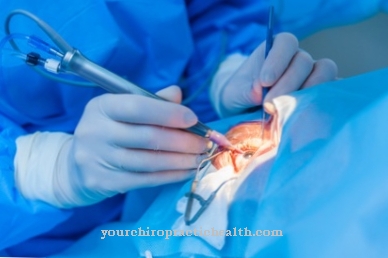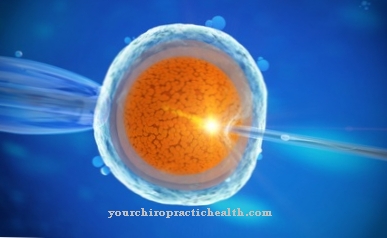As Cardioversion is the restoration of a normal sinus rhythm and frequency in the presence of a serious cardiac arrhythmia. In the vast majority of cases, cardioversion is intended to eliminate atrial fibrillation with a frequency of over 100 Hz and a noticeable loss of performance. In principle, cardioversion can be carried out with medication or by delivering a current impulse - similar to that of a defibrillator.
What is cardioversion?

Cardioversion is the qualitative and quantitative conversion of the heart rhythm in the case of a persistent (persistent) rhythm disturbance into a normal sinus rhythm with a frequency within the normal range of about 60 to 80 Hz without physical stress. In principle, cardioversion can be carried out with medication or with an electric shock, because in most cases it offers the higher success rate and a relapse into the arrhythmia occurs less frequently.
If the electrocardioversion (ECV) is successful, a (normal) sinus rhythm sets in immediately after the electric shock. Persistent arrhythmias in the form of atrial fibrillation are relatively common in men over 60 years of age. Atrial fibrillation with frequencies above 100 Hz is usually not immediately life-threatening, but must not be confused with so-called ventricular fibrillation, which is immediately life-threatening. If no organic causes for the arrhythmia or atrial fibrillation, such as heart valve defects or heart failure (heart muscle weakness), can be identified, the chances of success of a cardioversion are particularly high.
Function, effect & goals
Cardioversion is only used to restore a normal sinus rhythm to the heart if the arrhythmia is persistent.The arrhythmia can be in the form of atrial fibrillation, atrial flutter or an arrhythmia of the heart chambers (ventricles) in connection with an increase in frequency (tachycardia).
Atrial fibrillation is an arrhythmic and disorderly beating of the atria with a relatively high frequency of over 100 to sometimes 150 Hz. If the ejection volume of the atria is impaired by the disordered contractions, there is a noticeable loss of performance, so that the restoration of the sinus rhythm leads to a noticeable improvement in the patient's condition. The electrocardioversion, which is performed under short-term anesthesia, has the advantage of a higher and more sustained success rate over the attempt to convert the heart rhythm into drugs, depending on the type of arrhythmia.
The ECV is comparable to the effect of a defibrillator because the electrocardioversion also works with direct current. The main difference is that with ECV you get by with lower currents (50-100 joules) and that the timing of the electric shock is controlled by the EKG. The shock is applied at a time when the heart muscle cells are still working synchronously. The procedure increases the chances of success in converting the heart to a sustained sinus rhythm and minimizes the risk of ventricular fibrillation. If the arrhythmia has existed for more than 48 hours before the conversion, it must be clarified beforehand whether any blood clots (thrombi) have formed in the atria, which could cause an embolism or a stroke by being carried over into the bloodstream.
Any atrial thrombus that may be present can be detected using transesophageal echocardiography (TEE). For this purpose, the head of the ultrasound device is inserted into a probe into the esophagus. The echoes are sent to a monitor. The TEE also provides information about the functionality of the heart valves and the nature of the heart muscles (myocardium). Of particular interest is whether there is possibly a thickening (hypertrophication) that can lead to insufficiency in the long term. It is recommended that you take anticoagulants before and after cardioversion - including cardioversion with medicinal products. In both cases, the restored sinus rhythm should be supported with medication over a longer period of time.
In most cases, antihypertensive drugs are also needed, because z. For example, atrial fibrillation is often triggered by long-term hypertension. In the presence of defined arrhythmias, so-called catheter ablation can be considered as an alternative to electrical or drug conversion, in which one or more catheters are pushed through veins in the groin into the left atrium and targeted cells in the left atrium that are responsible for the arrhythmia are destroyed or their conductivity eliminated.
You can find your medication here
➔ Medicines for cardiac arrhythmiasRisks, side effects & dangers
The greatest risks of cardioversion, regardless of whether it is performed electrically or with medication, are on the one hand that further arrhythmias develop or that atrial thrombi that have formed during the course of the arrhythmia detach from the atrium after the conversion and channel them into the bloodstream become. At crucial points, they can occlude vessels and cause an embolism.
If the thrombi occlude a cerebral vessel, it comes to a stroke with corresponding symptoms and failure symptoms. This risk is kept extremely low by the previously performed TEE. With drug conversion, there is also the risk of harmful side effects of the drugs, which can be serious for certain patient groups with previous damage such as insufficiency of the myocardium or the heart valves and must be carefully considered. With an electrical cardioversion there is also a low risk of anesthesia due to the necessary short-term anesthesia. Temporary reddening of the skin can also occur at the contact points between the electrodes and the skin.
Burns at the contact points are extremely rare. More common are harmless sore muscles in the chest muscles, which disappear after a few days. Because of the prophylactic use of anticoagulants to prevent strokes and embolisms, severe bleeding can occur in rare cases with internal or external injuries.













.jpg)

.jpg)
.jpg)











.jpg)